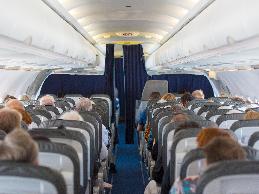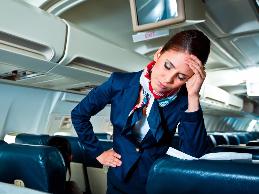Introduction
Employees with a variety of impairments may have difficulty traveling on the job. For example, an employee with anxiety may find it stressful to travel, an employee with a back impairment may have difficulty sitting when traveling, an employee who is blind may need alternative transportation or help navigating in a strange city, or an employee who uses a wheelchair may need accessible transportation.
In some jobs, traveling is an essential part of the job; therefore, the employee needs to be able to travel to be qualified for his/her position. In other jobs employees may travel, but there are other ways to perform the job without traveling.
When an employer requires on-the-job travel, the employer is responsible for providing accommodations such as alternative methods of transportation. Employers must provide accommodations unless they can show that the accommodations pose undue hardship. The following discusses some of the issues regarding travel-related accommodations:
Do employers have to provide accommodations for on-the-job travel such as driving to home visits?
Employers are responsible for accommodations such as alternative methods of transportation for work-related travel when driving is not an essential function of the job. For example, an employer must consider alternative transportation for a social worker who cannot drive due to vertigo; the essential function is completing the home visits, not driving. Employers must provide accommodations unless they can show that the accommodations pose undue hardship.
Do employers have to provide accommodations for employees with disabilities for work-related air-travel? What about paying for first class tickets?
Assuming the employees meet the definition of disability under the ADA, employers would have to consider paying for accommodations needed for work-related travel, for example purchasing two seats side by side for an employee with obesity. As with any accommodation, employers can look for undue hardship.
Regarding paying for first class tickets, employers can look for options. The employer should take a look at what the problem is and then explore possible solutions. For example, if effective, an employer might opt to purchase two coach seats. An employer could also look at business class or first class, but if purchasing two coach seats would be less expensive than business or first class and it would meet the employee’s needs, then the employer gets to choose when there is more than one effective accommodation.
Do employers have to provide personal attendant care for work-related travel?
According to informal guidance from the EEOC, the ADA does not require employers to provide personal attendant care on the job because reasonable accommodation does not require employers to provide personal need items or services. However, when an employee travels for work and incurs personal attendant care expenses beyond his/her usual expenses when not traveling for work, there is a good argument that the employer must pay the added costs.
Accommodation Ideas
The following are some accommodation ideas that might be effective for individuals who travel for work:
For an employee who typically is scheduled to travel by air, he/she might be able to use other modes of transportation, such as bus, taxi, rental car and train. Other accommodation possibilities might be audio conferencing and videoconferencing. If it is not essential that an employee physically be present at another location, either of these might be effective accommodations.
In some cases, the work might be done without traveling. Video and Web conferencing are becoming more and more popular in the corporate world. It allows people who are at two or more sites to have real-time communication, not just "talk" to each other by conventional telephones. It enables the people at one site to see a video picture of the people at other sites and communicate in real-time.
If neither the above suggestions nor other alternative accommodations are effective, another option might be reassignment to a vacant position that does not require traveling.
The person with the disability might want to take the initiative to talk to her/his doctor to determine if there are treatments that can help overcome this new fear of flying or traveling.
Situations and Solutions:
The following situations and solutions are real-life examples of accommodations that were made by JAN customers. Because accommodations are made on a case-by-case basis, these examples may not be effective for every workplace but give you an idea about the types of accommodations that are possible.

An applicant disclosed that she has cataplexy and mentioned concerns with the on-the-job travel duties required for the position.
Occasional travel via rental car is listed as a function of the job to attend conferences. The employer agrees to arrange for transportation via bus instead of rental car if the applicant is selected for the position.

An applicant with blepharospasm raised concerns about the on-the-job driving duties required for the position.
The employer arranged for another employee to perform the driving duties as an accommodation. The employer felt this was a marginal function because the employee rarely traveled alone due to the nature of the job.

A marketing professional with quadriplegia was required to travel to multiple conferences a year.
She had a hard time navigating airports and traveling to the conference center once at her destination. As an accommodation, the employer coordinated her travel arrangements with the airport whom then provide mobility assistance. The employer also hired a work-related travel aid to assist the employee once at the final destination.

A flight attendant with chronic fatigue syndrome was missing a lot of work due to fatigue.
Her doctor recommended that she reduce the amount of traveling she was doing. She wanted to continue working full-time so requested reassignment to an office job.

A university professor who is blind had to attend a conference once a year.
He was provided with a sighted guide to assist him with travel and with navigating the hotel and conference center.

An account representative was out of leave due to treatment for Hepatitis C.
The employee wanted to return to work, but due to side effects of treatment, could not maintain the stamina needed to visit clients. The employer reassigned the employee to another account representative position that did not require travel.

A driver with seasonal affective disorder (SAD) who picks up and delivers clients to various appointments began to forget waiting clients as well as the routes she needed to travel in order to deliver them to the appropriate facility.
When her employer mentioned the mistakes, the driver broke down. She described her depression and anxiety with the change of seasons and how it affected her memory. The use of reminder apps, as well as those to help with directions, were discussed as possible accommodation solutions.

An accountant with spasmodic dysphonia needed time off periodically to travel out of state in order to get specialized medical treatment to manage his condition.
He also experienced a breathy voice quality that limited his ability to speak loudly for several days after each treatment. The employer granted periodic leave and provided equipment to amplify his voice on the telephone as needed.

An employer, trying to accommodate an employee returning to work after a leave, had questions about the stress of required travel that escalated the employee’s depression and anxiety.
The employer was advised to continue on in the interactive process to discover what specifically about the travel was stressful so they could determine accommodations for those identified issues. Examples of questions to ask could include what particularly about the travel causes the stress that heightens the depression, such as the length of the travel, the distance, the planning process, or even specific modes of travel and/or locations.

A special education teacher with agoraphobia had been off on leave for a school year.
With her psychiatrist’s help, she determined that she could return to work if the school was within a five-mile radius of her home – the distance she and her doctor considered safe for her to travel. There were actually six schools within that area. She asked for an accommodation of being placed in one of those particular schools when a special education position came open. The teacher was actually given the choice of two schools right off as the district knew those particular jobs were going to be open for the next year. She accepted the offer on the elementary position, since she felt most comfortable with that age group.

A graphic designer with a panic disorder experienced recurrent panic attacks when traveling during peak traffic times.
He was required to drop off design orders and pick up print proofs from a print shop when necessary. He was accommodated with a schedule that gave him the opportunity to drop off and pick up materials when coming to work in the morning.

A salesman with obesity had to travel by airplane once a year to attend a conference, but could not fit in a single, economy class seat.
He asked his employer to upgrade him to first class, but the employer opted to purchase two economy class seats for him, which cost less than one first class ticket.

A retail manager who travels a fair distance in rush hour traffic asked to be reassigned to a location near her home where she could commute on less traveled local roads that would cause her much less anxiety.
Her request was denied because there were no openings in the store closest to her, and her position in her current location was needed there. She was given the choice of a schedule change as an accommodation so that she could arrive slightly before / after the rush hour.












